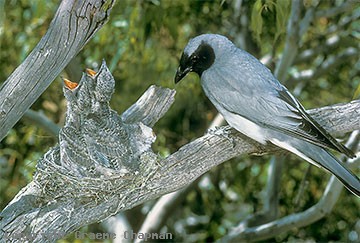| Australasian Grebe | Tachybaptus novaehollandiae | Common on large dam. |
| Australian Hobby | Falco longipennis | Uncommon. |
| Australian King-Parrot | Alisterus scapularis | Common resident. |
| Australian Magpie | Gymnorhina tibicen | Common over most of the reserve, especially in the paddocks. |
| Australian Pelican | Pelecanus conspicillatus | Usually in flight to or from Lake Burley Griffin. |
| Australian Raven | Corvus coronoides | Common crow like bird. |
| Australian Wood Duck | Chenonetta jubata | Common around the large dam. Roosts in trees. |
| Black-faced Cuckoo-shrike | Coracina novaehollandiae | Common. A large proportion of the population is migratory. |
| Brown-headed Honeyeater | Melithreptus brevirostris | Uncommon. |
| Brown Falcon | Falco berigora | Sometimes seen on light poles near Glenloch Interchange. |
| Brown Goshawk | Accipter fasciatus | Common. May have bred in the lower woodland. |
| Brown Thornbill | Acanthiza pusilla | Common. |
| Buff-rumped Thornbill | Acanthiza reguloides | Common. |
| Collared Sparrowhawk | Accipter cirrhocephalus | Uncommon, with most individuals leaving in winter. Breeding has occurred in the pine grove. |
| Common Blackbird | Turdus merula | Common introduced bird along the urban fringe. |
http://www.friendsofarandabushland.org.au/flora-and-fauna/birds/

http://commons.wikimedia.org/wiki/File:Australasian_grebe6535.jpg
Australasian Grebe = Tachybaptus novaehollandiae
The Grebe bird is a very small bird (some details come from the chart above) that live on the Pacific parts of the ocean. Fun fact, these birds are unable to fly for a long, so to make up for their unablility to fly well, they are great swimmers and divers. If the birds have chicks, both parents take care of the chicks and are very protective of their little ones.

http://www.birdphotos.com.au/Australian%20King%20Parrot/slides/kingparrot2.html
Australian King-Parrot = Alisterus scapularis
The King Parrot lives in the deep forests and humid regions of Australia. To tell the difference in the male and female bird is by looking at the color of the bird on their beaks, heads, wings, and chest. The easiest way you can tell between the two is the beak; the females is a gray color and the male has a yellow beak with a black color at the tip of the beak. A fun fact about the Australian King Parrot is that there are three different sizes and they have been around since the early 1800's. It is very rare to see these birds alone, they stay in big groups and keep each other as good company.

http://www.graemechapman.com.au/library/viewphotos.php?c=94
Black-faced Cuckoo-shrike = Coracina novaehollandiae
The Black-faced Cuckoo-shrike are highly protected by the National Parks because of predators and hunters. These birds are found wooded areas, but not in rainforests. They do not change much appearance from when they are chicks to adult hood because they stay gray/white and the only difference is they get a black mask on their faces and tips of their wings. Fun fact, the Coracina nocaehollandiae are not closely related to cuckoos or shrikes. They just have cuckoos and shrikes in their name because they take off flight identically to the cuckoos and shrikes. When one finds a Black-faced Cuckoo-shrike, they will see them in pairs and singing their little hearts away.
References:
Boles, Christidis, and Walter Boles. "Systematics and Taxonomy of Australian Birds." Google Books. CSIRO, 2008. Web. 16 Apr. 2014.
References:
Boles, Christidis, and Walter Boles. "Systematics and Taxonomy of Australian Birds." Google Books. CSIRO, 2008. Web. 16 Apr. 2014.
No comments:
Post a Comment